Cutting in Trim and Corners
These tricky transition areas require not only the right technique but also the right brush.

One of the benchmarks of a good paint job is crisp, straight transitions of color where trim meets a wall or a wall meets a ceiling. I’ve found that cutting in these areas is as much about having the right tools as it is about having the right technique. It all starts with the right brush.
My favorite is a Corona 2-1/2-in. Excalibur angled sash brush. First, it works well with both oil- and water-based finishes. It’s also good for a wide variety of painting tasks besides cutting in, and its Chinex bristles are long-lasting and easy to clean (see “Building Skills”, FHB #210).
Most painters, pros and do-it-yourselfers alike, hate cleaning brushes; even some pros wrap their brushes in plastic wrap or aluminum foil for later use. Unless I’m in an extreme rush, though, I don’t do it. Clean bristles produce a much better finish, and it really doesn’t take long to clean a high-quality paintbrush.
Having a clean brush is so important that I wash my brushes both at lunchtime and at the end of the day. In hot or dry conditions, I may wash my brush three or four times a day. The problem with storing brushes in plastic wrap, foil, or even zip-top bags is that the paint near the top of the bristles dries in a few hours and becomes difficult to remove completely. Before long, the bristles don’t hold as much paint or flex as they should, which contributes to a rough finish and ragged lines where you’re cutting in.
Besides the brush, you need a paint pail. I like metal pails because they don’t flex unnervingly like plastic pails; however, the seams in metal pails make them more difficult to clean. If you find this a problem, look for a paint store that sells liners for metal pails. I use them whenever I’m changing colors several times a day.
I fill the pail about one-quarter full so that there’s plenty of room to tap off excess paint on the side. Generally, I find high-quality, well-mixed paint (I like Benjamin Moore) to be fine right out of the can, but in extremely hot or dry conditions, a paint additive such as Floetrol or Penetrol (www.flood.com) can reduce brush marks and even the transitions between brushed and rolled areas. Follow the additive directions carefully to avoid problems.
Step by Step: A kit for cutting in
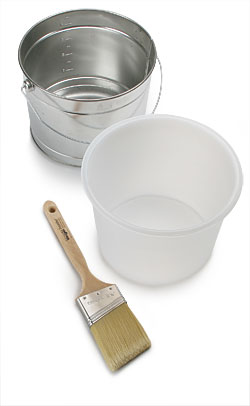
Cutting in nice, straight lines starts with the right brush and a high-quality paint pail. A good choice is an angled sash brush with Chinex bristles. This bristle works well with both oil and latex paint. Pails come in several sizes. Choose one that’s comfortable to hold and has enough room for tapping excess paint off the brush.
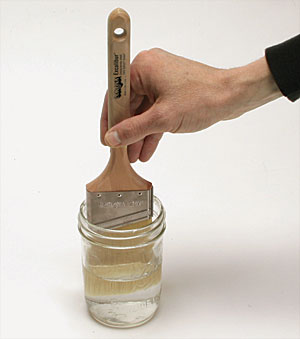 |
1. Wet the bristles. Before painting, wet the bristles in the appropriate solvent (check the can), and then squeeze out the excess. This makes cleanup easier and prevents paint from creeping up the bristles. |
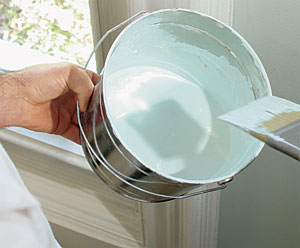 |
2. Get a grip. Hold the pail with four fingers on the bottom and your thumb wrapped around the handle. Keep only an inch or two of paint in the pail to keep your brush and workspace clean and to minimize spills. |
 |
3. Take a dip. Dunk the brush into the pail so that paint covers about one-third of the bristles. You can adjust the paint depth by tipping the pail slightly to the side. |
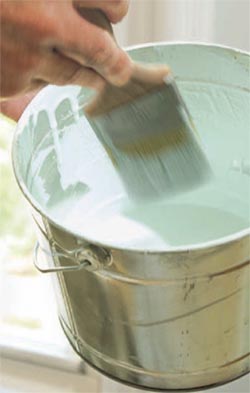 |
4. One tap. Tap one side of the brush against the side of the pail, and then gently drag the bristle tips over the rim.
While painting, keep the pail in your left (or nondominant) hand for maximum productivity. |
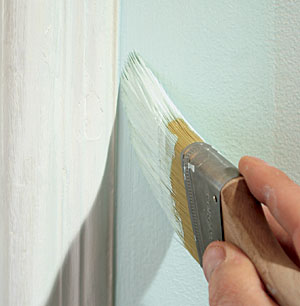 |
5. Apply the paint. Starting from 1/2 in. to 1/4 in. away from the trim or ceiling, use a single stroke to apply the paint. Looking slightly ahead of the bristles, pull the brush toward you; keep dragging until the paint stops covering. |
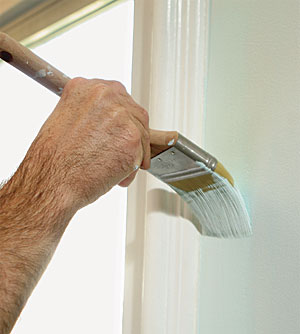 |
6. Work it out. With the brush rotated 90°, take a second pass with the bristles just touching the trim or corner. The paint should level out, leaving a smooth line free of ridges.
Take a third pass only when necessary. |
Photos: Rob Yagid





